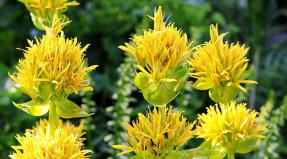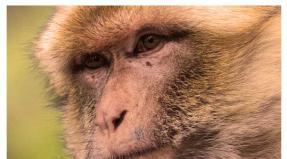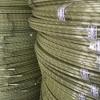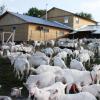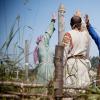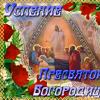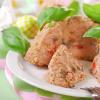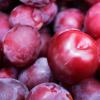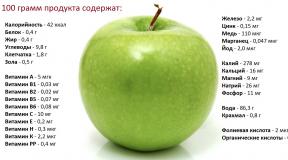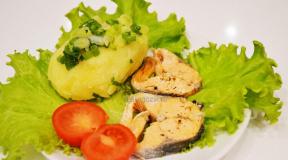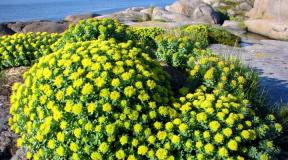Seasonal changes in nature. “Admire: spring is coming ... Message seasonal changes in nature excursion
Municipal budgetary educational institution
"Secondary school No. 21", Kaluga
Excursion
"Spring Changes in Nature"
Prepared
primary school teacher
Salnikova Julia Igorevna
Kaluga
2014
Excursion on the topic: "Spring changes in nature"
Grade 2
Goals:
I . Educational:
1. Formation of ideas about spring changes in nature.
2. Formation of ideas about the signs of the onset of spring.
II . Developing:
1. Development of observation
2. Development of logical thinking based on the development of logical operations.
3. Development of independence in the performance of individual - group tasks.
III . Educational:
1. Education of respect for nature.
2. Education of a culture of behavior in nature.
Equipment:
For the teacher: scoop for digging up primroses, thermometer, illustrations (birds (rook, lark), plants (goose onion, poplar, aspen), insects (urticaria butterfly, mourning butterfly, forest wasp)), boxes for collected material.
For students: hard cover notebook, pencil, colored pencils.
PROCEDURE OF THE EXCURSION:
I . PREPARATORY WORK.
1. Folding book display:
goose bow- herbaceous bulbous plant. Plant height - from 3 to 35 cm. Plants may have one or more bulbs. Some species have two types of roots: going from the middle of the bottom vertically down, and going from the edge of the bottom, first down, and then horizontally and up. The flowers are small, yellow, star-shaped. Pollination occurs with the help of insects that are attracted to nectar. Grows on moist soils: in forests, shrubs. Distributed in Europe and Asia.
Coltsfoot- a perennial plant that grows on clay soil, in fields and ravines. The underside of the leaves of the coltsfoot evaporates water weaker than their front side, and therefore their lower surface is warmer than the upper one - hence the Russian name of the plant. Underground branched creeping rhizome in early spring produces above-ground stems covered with brownish, scaly leaves. A yellow flower develops on this stem. Distributed in the European part, in the Caucasus, in Siberia to Baikal, in the cities of Central Asia.
forest wasp- an insect, 15-20 mm in size, lives in families in nests suspended on tree branches, under the roofs of houses and other buildings. Coloration yellow-green.
mourning house – The butterfly is quite large: the wingspan is up to 7.5 cm. The color of the wings of the male is dark brown, cherry-brown, the female is light brown. Wings with a wide light yellow border and a number of blue spots in front of it. On the front edge of the wings, 2 large yellowish-white spots. The underside of the wings is dark. The lighter wing rims of hibernating individuals are associated with fading during hibernation. Butterflies of this species can be seen near puddles on the roads, as well as on trees with sap flowing out. Mourners are big lovers of juices and often gather for a joint meal. Its first flight can be observed in early spring. The new generation appears at the end of July and flies until late autumn, when it leaves for the winter. The female lays up to 100 eggs in dense clutches in the form of circles on the branches of plants. Caterpillars develop from June to July.loose and attached head down. The pupal stage is about 11 days. There is one generation per year. Winters in hollows and other secluded places.
Rook- The rook is very similar to the black crow and can be distinguished by a bare circle around the beak, extending to the very eyes. It can also be seen by a very elongated beak and by small feathers on the head and neck, which have round edges, which the black crow does not have. The plumage of the rook is beautiful, black and blue with a purple sheen, 43 centimeters long. lives in alleys, parks and large gardens near fields, meadows, pastures, as well as in small groves, in the steppes and along river banks. Rooks build their nests on tall trees, often near habitation; the nest of the rook is so loose that, falling to the ground, it falls apart, which does not happen with the nests of other birds of the same kind. In April, eggs appear in the nests. These birds nest in large colonies.
field lark- the plumage of the lark is very modest, brown above, white below, light, even whitish, usually with dark spots and stripes. The lark is found everywhere, with the exception of the far north. It is found everywhere both in grain fields and in wastelands overgrown only with heather on dry, barren soil, as well as on oily soil, in pastures, pastures, on alpine logs, and even on islands and along the shores of the seas.
The lark always nests on the ground and generally runs beautifully and quickly, moreover, on the run, it raises feathers on the crown of the head. The lark flies south from us in September and gathers in huge flocks before leaving. Returns to us in early spring, depending on the climate, in February or March. Since the lark feeds on insects, it must be valued not only as a cheerful, pleasant singer of our fields, but also as a useful bird that destroys various harmful insects from our crops.
2. Preparing children for the story of a poem about spring and folk signs.
II . IDENTIFICATION OF STUDENTS' REPRESENTATIONS.
Guys, listen to the poem that Oksana will tell you.
Nature has not woken up yet
But through thinning sleep
She heard spring
And she smiled involuntarily.
Tyutchev. F
What time of year is this poem talking about?
About spring
Today we have a lesson-excursion and we will go to the park to observe what changes have taken place in animate and inanimate nature with the advent of spring.
What seasons do you know?
What season is it now?
What season precedes spring?
When is the day longer in spring or winter?
When is it warmer in spring or winter?
What signs of the onset of spring have you seen?
Well done, now open your notebooks and write down today's date and topic (on the board: Excursion. Spring changes in nature).
Card #1
1. Find a spruce. Consider it. Highlight the signs by which you learned that it was a spruce (trunk, branches, needles). Highlight what has changed in appearance compared to winter.
2. Draw a spruce branch. Try to reflect the changes that have taken place.
TO  art #2
art #2
Excursion. Spring changes in nature.
1. Find willow. Consider it. Highlight the changes that have occurred since winter.
2. Draw a willow branch. Try to show the changes that have taken place in the picture.

Card #3
Excursion. Spring changes in nature.
1. What insects can be seen in spring. Where can they be seen? What are they doing?
2. Use the net to catch the nettle moth.

Card number 4
Excursion. Spring changes in nature.
1. Consider the appearance of the rook. What size is it? What color is the plumage of the head, body, wings, tail? Describe the behavior. What is the rook doing?
2. Draw a rook.
Guys, we came to visit nature. Let's remember how to deal with yourself so as not to harm nature. (Children list the rules of behavior in nature).
People have long noticed the changes that occur in nature at different times of the year, compared them. These observations are reflected in signs, sayings. Does anyone know examples of such signs?
Rook on the mountain - spring in the yard.
The swallow has flown in - soon the thunder will rumble.
Long icicles for a long spring.
How do you understand these proverbs?
Well done. Today we will observe the changes that have taken place and find out how they are interconnected.
Pay attention to the sky. What color is it? What color was it in winter?
Guys, stand so that the sun illuminates your right hand. What do you feel?
The sun rises above the horizon in spring, the day becomes longer, so more heat falls on the earth and the air temperature in spring is higher than in winter. Let's measure the temperature and compare it with the temperature in winter (they measure and mark in their notebook).
What was the land covered with in winter? Is there snow now? What has he become?
Where do you think so much water could have gone?
A large amount of melt water flows into reservoirs, so in spring you can see such a phenomenon as high water - the rise of water in reservoirs.
But not all water flows into reservoirs, part of it is absorbed by the soil, from where it can be absorbed by plant roots.
What happened to plants in winter?
See what has changed in the appearance of the trees?
At first glance, it seems that no changes have occurred in the life of trees with the advent of spring. Let's get closer to the birch and see if we notice any changes.
On the birch branches, the buds became larger - they swelled up and slightly opened their protective scales, from under which you can see green leaves.
Well done. What made these changes happen?
Externally, trees and shrubs have changed, although they have long "felt" the arrival of spring. The soil thawed, allowing trees and shrubs to absorb water and nutrients from it, which travel up the trunk to the buds, dissolving their sugar stores. This phenomenon is called sap flow. If a hole is made in the tree trunk at this time, then juice will come out of it. Many birds feed on the sap of trees, such as the woodpecker, but the holes they make to extract the sweet sap are very small and do not harm the tree. But the notches that people make when collecting sap can lead to the death of a tree. If you see such a notch walking through the forest, then help the tree, for this, cover the wound with plasticine or clay.
Look at the willow, what changes do you observe compared to winter?
Fluffy buds appeared.
Guys, these are willow flowers. Many trees and shrubs bloom in spring: willow, alder, hazel, poplar, maple (I show illustrations of flowering trees).
We looked at the changes that have taken place in the life of trees and shrubs, their buds swelled, some showed green leaves, many of them bloom. In order to observe what changes will happen to them further, we will take several branches of willow, birch to the class and put them in the water. You will also have to continue observing plants in nature according to the plan:
1. The beginning of sap flow (for maple and birch).
2. Swelling of the kidneys (appearance of lighter internal parts in the kidneys).
3. Budding (green tips of young leaves become visible).
4. Beginning of leaf deployment
5. Flowering of early-flowering trees and shrubs (willow, hazel, etc.).
And what changes have occurred in the life of herbaceous plants (The teacher points to an early flowering plant)? Does anyone know what this plant is called?
Coltsfoot
What interesting things can you tell about it? What other early spring blooming plants do you know? (pointing to corydalis and goose onions) Now we will carefully dig out some early flowering plants to study them in more detail in class, and we will plant one plant in a pot and observe how it develops and what changes will occur with it.
Look at the coltsfoot flowers, who can you see on them?
Insects.
What insects can we observe in early spring? What can you tell about them?
Well done. Listen, what sounds did you hear?
Birdsong?
Have you heard it in winter? What birds could not be seen in winter, but now you can? Are there any birds that disappeared with the advent of spring? Which? What is the reason for such changes in the behavior of birds?
Have you noticed what the birds are doing now?
They build nests.
What materials do they build their nests with?
And so, guys, what changes in nature have we already been able to identify?
III . INDIVIDUAL-GROUP WORK.
And now each group will have to complete the tasks that are given on the cards. When performing them, we do not forget about the rules of behavior in nature. You have 10 minutes for this.
IV . GENERALIZATION.
- What signs of the onset of spring have we observed?
What animals and plants did we observe?
And now back to class.
v. CAMERAL PROCESSING.
Open the notebooks in which you wrote down the date and subject. Now we will record the results of our observations.
What was the weather like during the tour? What was the temperature? Was it sunny or overcast, windy or not? Write down your observations in your diaries, and the attendants will also write them down in the calendar of nature and labor.
What changes have occurred in the life of plants with the advent of spring?
What changes have occurred in the life of insects and birds in spring?
You completed the tasks on the cards, now each group will tell the others what they observed.
What changes have occurred in the life of coniferous plants (for example, spruce)? We write down
What did group 2 observe? What changes have you noticed? We write down
What did group 3 observe?
We dug up early flowering plants, and the 4th group caught a urticaria butterfly, now we must prepare everything for the herbarium.
So, everyone is great today. The observations made today will be useful to us in the following lessons.
Bibliography:
Pleshakov A.A. Atlas - determinant "From the earth to the sky." A guide for students of secondary schools.: Education, 2009 - p.222
Kiseleva K.V.Atlas-determinant "Flora and fauna of central Russia".: Fiton, 2010 - p.544
Sections: Working with preschoolers
Seasonal excursion "Early autumn"
Target: to show children the multicolor of the world around us: the more we peer into nature, the more colors and their shades we see.
It's early autumn now. Much in nature at this time resembles summer. But a lot has changed.
1. Watch the weather, compare.
2. See if the color of the trees has changed on the trees and shrubs.
3. Game: using a mat to examine the leaves. Look for shades of color.
4. Watch insects and birds, animals, establish changes in their lives.
5. The game "Camera".
6. How unusually beautiful nature is in autumn! How many different colors can you see around you? (The color of wildlife is green, note the shades). Lead to the conclusion that although the dominant color is green, but the world at any time and in any place is multi-colored.
Seasonal excursion: "Late autumn"
Target: observation in the same environment, but under different conditions. How has the color changed?
In late autumn, the sun does not rise as high in the sky as in summer, the days become shorter, and the nights are longer, cooler; low gray clouds, lingering drizzling rains, thick fogs, frosts, cooling of water and soil: the color of leaves changes in trees and shrubs, leaf fall occurs, grasses wither, in many plants fruits and seeds ripen and spread; insects disappear, migratory birds fly away to warmer climes, other animals prepare for winter.
- How have the conditions for the existence of living organisms changed?
- How has the life of nature changed compared to early autumn?
- How has the color changed?
- What colors do you see?
- Why are there no bright colors?
- Why don't bright flowers bloom?
- How is the habitat different from the previous seasonal excursion? Take plush toys on an excursion and with their "help" collect seeds of winter plants. How did they get on plush animals? What for?
- Game: "What do I see above, below, sideways?" - "In a circle" how the habitat differs from the previous seasonal excursion
Seasonal excursion: "Colorful winter"
Target: to show children the miracle of white color, to see trees in winter, mosses and lichens - in this habitat, where they usually go on seasonal excursions. Collect broken branches, lichens and mosses for a winter forest model.
- In winter, a forest or a park may seem lifeless. Insects are not visible, many birds have flown to warmer climes. But the forest and the park live a special, winter life. To find out about it, we go on a tour. (Take bird food with you).
1. See what has changed compared to autumn: the weather, the color of the sky, the appearance of the forest or park.
2. Consider trees, shrubs, conifers, pay attention to the diversity of tree bark.
3. Dig up the snow with a spatula and consider how plants (mosses and lichens) hibernate under it.
4. Watch the animals.
5. Admire the winter forest, snow.
6. Collect broken branches and formed mosses and lichens for the winter forest model.
There is a certain culture of communication with the winter forest. The main rule is do not harm beauty.
White hats on the branches, smooth snow surface, a bizarre pattern of footprints of different animals. Of course, there will be no harm to nature if a person scatters snow in vain, showers it from the branches, tramples the tracks of animals. The beauty of the forest will be restored after the first snowfall. And yet, while communicating with the winter forest, try not to destroy its beauty even for a day, even for an hour. Let the people who come to the forest after you see not the traces of your stay here, but the white fabulous palace, in which it is so pleasant to be.
And one more thing: do not leave any garbage in the forest! In winter, the garbage is not noticeable - the snow will hide it, but in the spring, when the snow melts, it will become clear how much garbage people brought here. A lot of work will have to be spent to remove it. And will it be possible to remove everything?
FIRST SNOW.
Silver, lights and sparkles, -
A whole world of silver!
Birches burn in pearls,
Black and naked yesterday.
This is the realm of someone's dream
It's ghosts and dreams!
All items of old prose
Illuminated by magic...
The embodiment of dreams
Life with a dream is a game.
This world of enchantments
This world is made of silver.
WINTER PAINTS
Harvested winter
Paints all for all by herself
Field - the best whitewash,
Dawns - scarlet ink,
All trees - pure silver sparkles,
And on the street I decorated the guys in a row
How an artist paints in different ways:
Who plays, paints red,
Who is afraid to move -
Red paint is fine.
Don't beg for anything
Color differently.
Fetisov V.
Seasonal tour: "Colorful spring"
Target: observe seasonal changes, show the tenderness of the colors of spring, the beauty and fragility of primroses. Apply the techniques of ecological excursion.
HOD: Spring. The sun rises higher in the sky than in winter. The days are getting longer and the nights are getting shorter. Warming, melting of snow and ice, ice drift, flood, it is no longer snow, but rain, sometimes with a thunderstorm, the soil has thawed; early-flowering plants bloom first, and then other plants, grass turns green, young foliage appears on trees and shrubs. Insects, frogs, toads, lizards appear, migratory birds return from warm countries, almost all birds build nests and hatch chicks, most animals give birth to cubs.
1. Observe the weather and compare it with the weather in winter.
2. See in which places the snow has already melted, and in which places it is still preserved. Does the appearance (color) of snow in spring differ from its appearance in winter
3. Observe whether the appearance of trees and shrubs has changed, whether buds have appeared.
4. Observe if insects have appeared, in what places they are kept, if frogs and other animals have appeared that were not there.
5. Pay attention to the change in the life of birds and animals.
6. Listen to the voices of birds.
7. Admire the beauty of trees, note the beauty and fragility of primroses.
8. Note the tenderness of the colors of spring.
9. D / game "Ecological path". Purpose: to consolidate the rules of the friends of nature.
Seasonal excursion: "The sun and the magic rainbow". Summer.
Target: to give children the opportunity to understand the nature of color and the reasons for the diversity of the world.
HOD: Guys! Listen to the riddle. (About the sun). The sun is the source of light and heat for all living things. What do the rays of the sun bring us? The rays of the sun bring us life. Why? (Answers of children). Can we say that the sun is an artist? Why? (Children's answers). Look at the world around us, nature. It is dyed in various colors. What's the beautiful! Unique beauty. How nice it is to live in such a world, what colors can be found in nature? (Children's answers). When mixed, colors form different shades. And what are the shades and from what colors can they be obtained? (Answers of children). So who colors our world? (Answers of children). The sun and rays are masters of coloring. And where are all the colors of the world collected? (Answers of children).
I stand and rejoice
Rainbow, rainbow!
Stripe to stripe
Line - to line:
Yellow, green, red, blue. . .
I was told that it is
All from sunlight.
If you mix them together,
There will be light again.
The rainbow is a palette for colors, where the sun with its rays mixes colors and colors nature.
What color is more? (Answers of children). What is more green? (Answers of children). Green trees, grass, shrubs, flowers, etc. Why do we need plants? (Answers). Plants provide oxygen that all living creatures on our planet breathe, including humans. Could this mean that green is the color of life? (answers). And we can say that our planet Earth, where we live, is a green house, where trees are the source of life for you (answers).
D / game "Catching a sunbeam"
Guys, let's draw the palette of the sun - a rainbow and our green house - our planet and the source of all life - a tree.
Material: multi-colored crayons, sample.
Send your good work in the knowledge base is simple. Use the form below
Students, graduate students, young scientists who use the knowledge base in their studies and work will be very grateful to you.
Posted on http://www.allbest.ru/
Plan
Introduction
1. Excursion as a stage in the formation of generalized ideas about a particular season
2. The role of excursions in the system of work on environmental education and upbringing
3. Preparation of the teacher and children for the excursion
4. Basic requirements for the methodology for conducting seasonal excursions
5. Working with children after the tour
Conclusion
Bibliography
Introduction
Currently, the system of preschool education is experiencing the contradictions of the transition period. The old principles of work are gradually becoming obsolete, and they are being replaced by new concepts and ideas.
The educational process in the preschool educational institution is characterized by an increase in the volume of intensity of educational and cognitive activity, additional subjects are introduced into the curriculum, which inevitably leads to a decrease in the already insufficient level of physical and emotional development. There is a need to provide pedagogical conditions that make it possible to flexibly implement various types of activities into a single educational process.
Integrated classes correspond to one of the main requirements of preschool didactics: education should be small in volume, but capacious.
Such classes within the same topic solve different problems of the development of children and are based on different types of activities.
Integrated classes allow the child to realize their creative abilities, enrich the vocabulary in an interesting, playful way, develop communication skills, cognitive interest and activity.
In the field of environmental education, integrated classes play an equally important role: the educator develops the aesthetic perception of nature in children, the ability to feel and alter its beauty; forms ecological ideas about the environment.
S.N. Nikolaeva in her research showed that “the task of improving preschool education is not to expand the scope of knowledge through the inclusion of additional factual material in the program, but to search for the principles of its systematization, which will make it possible to acquaint children with some significant connections between objects and phenomena of the surrounding world.”
1. Excursion as a stage in the formation of generalized representationsabout this or that season
An excursion is a collective visit to certain objects for an educational or scientific purpose. Excursions also pursue the goal of broadening one's horizons, the general cultural development of a person.
Modern approaches to the organization of environmental work with preschool children are based on providing children with maximum opportunities for organizing direct contacts, communication of the child with the natural world. That is why a special role in familiarizing children with nature belongs to excursions, which are one of the organizational forms of education in a preschool institution. They provide an opportunity in a natural setting to acquaint children with natural objects and phenomena, with seasonal changes, with the work of people aimed at transforming the environment. During excursions, preschoolers begin to learn about the natural world in all its diversity, development, and note the interconnection of phenomena.
In the process of excursions, the foundation of specific ideas about native nature is laid. Children get acquainted with all the richness of its colors, sounds, smells, forms in development and change. Cognition of the natural environment begins in a sensual way, with the help of sight, hearing, touch, smell. So, in the forest, in the park, children learn to distinguish the color of autumn foliage: in birch it is lemon-colored, in oak it is brown, in willow it is greenish-yellow, in aspen it is red or purple. The picture of the autumn forest, the park is perceived by them brighter, more fully, if the teacher offers to listen to the voices of birds, the sound of the wind, the rustle of leaves, teaches them to identify the smell of mushrooms, rotten greenery. The more sense organs are involved in such cognition, the more signs and properties the child identifies in the object under study, the phenomenon, and, consequently, his ideas become richer. On excursions, preschoolers get the opportunity to directly get acquainted with the properties and qualities of objects, phenomena through observations, in the course of performing tasks of a game or practical nature. Thus, sensory development is carried out, on the basis of which thought processes, imagination arise, and aesthetic feelings are formed.
Excursions are a special type of activities to familiarize children with nature outside the preschool institution.11 The advantages of excursions-classes is that here children have the opportunity to gain knowledge and information about natural objects and phenomena in a natural setting.
Excursions to the forest, in the field, on the banks of rivers and lakes attract the attention of children, provide an opportunity, under the guidance of an educator, to collect a variety of material for subsequent observations and work in a group, in a corner of nature. On excursions, children develop observation, interest in the study of nature.
They learn to peer into the subject and notice its characteristic features. The beauty of nature evokes deep feelings in the children, indelible impressions, and contributes to the development of aesthetic feelings. On this basis, love for the native nature, a careful attitude towards it, love for the Motherland is formed.
A significant place in the formation of ideas about seasonal changes during excursions is given to the method of observation. Observation is a purposeful, systematic, more or less long-term perception of objects, objects, phenomena of the surrounding reality.
Observations of vivid pictures of nature - a forest during golden autumn and during leaf fall, a flowering meadow at the beginning of summer, an ice drift on a river - affect the child's emotional sphere, affect various analyzers, and provide a clear perception of phenomena. It is equally important to make the characteristic changes in living and inanimate nature the subject of observation in all age groups. The main link in this work is the establishment of signs of the season (length of daylight, air temperature, cloudiness and precipitation, etc.). It is advisable to start observations with inanimate nature, since changes in the life of plants and animals depend on it. Already children of middle preschool age can establish a connection between the abundance of sunlight in the spring and the beginning of the awakening, growth and development of plants. Older preschoolers can also realize more complex connections that do not have such a vivid external expression. For example, in autumn they discover that the departure of feathered birds is related to air temperature: with a cold snap, some insects die, others climb under the bark, tree roots, fallen leaves, moss, and the birds are left without food, which pushes them to move to warmer climes.
Children's attention should also be drawn to the facts of the adaptation of animals and plants to adverse environmental conditions. This can be shown by the example of how birds and animals prepare for winter, adapt to changing food conditions, cold weather, and snow cover. Already children of middle preschool age, thanks to systematic observations on excursions and walks, understand that with a cold snap, birds move closer to human habitation, and some fly away to warmer climes. Older preschoolers learn that with the onset of winter, some animals hibernate (bear, hedgehog, toad, frog), others move to where they find food (nomadic birds, elks, deer), others store food (rodents). It is important to draw the attention of children to the fact that with the onset of winter, the hare, the squirrel changes color, warm light wool (fur) grows.
During the excursion into nature, a significant place is occupied by the performance by children of various practical tasks that follow from its content and provide effective knowledge of those objects and phenomena that children observed earlier. Most often, this is the collection of natural material intended for further observations in a corner of nature, for crafts, equipment for classes (for example, cones for mathematics classes).
At the end of the tour, it is advisable to organize didactic games that reinforce the acquired knowledge in an entertaining way. So, in the forest, the game "Find a tree by leaf" (senior group) is held, after getting acquainted with garden crops - the game "Find out by description" (middle group).
A few days before the excursion, the teacher conducts a short conversation with the children in order to arouse their interest in the upcoming lesson, revive impressions and ideas that may be useful during the excursion, informs her purpose. Children should know where they will go, why, what they will see, what needs to be collected.
Before the excursion, the educator carefully considers what material should be collected for further work in the group and what equipment should be taken with you in this regard. All equipment must be in a specific location.
Thus, excursions into nature are an effective means of education and training, since in their process the harmonious development of all aspects of the personality of a preschooler is carried out. In communication with native nature, the foundations of a materialistic understanding of the world around are formed, moral and aesthetic qualities are brought up, good feelings are awakened. To educate children's interest in and love for their native nature means to raise its true friend, the future caring owner of the wealth of their homeland.
2. The role of excursions in the system of work on environmentalRussian education and upbringing
Excursion- a special form of cognitive activity of children and adults in the system of environmental education and upbringing. It includes the preparation of the educator for the excursion (development of program tasks, determination of the place and route, preparation of children for the excursion, selection of equipment for collecting natural material, use by the educator of various methods and techniques on excursions, organization of various activities for children.
The advantage of excursions is that they allow children to get acquainted with certain objects of observation in a natural setting.
It is advisable to conduct natural history excursions to the same places at different times of the year in order to show children the seasonal changes that occur in nature.
An excursion is much more difficult to conduct than an organized activity in a group, so its success depends on the careful preparation of the teacher and children.
On excursions, children get acquainted with plants, animals and their habitat, and this contributes to the formation of primary ideas about the relationships in nature. Excursions contribute to the development of observation, the emergence of interest in nature.
The role of excursions in the aesthetic education of children is great. The beauty of nature surrounding them causes deep feelings, promotes the development of aesthetic feelings. Excursions into nature are associated with the stay of children in the air, with movement, which helps to improve health. Being in the forest, on the banks of the river, children collect a variety of material for subsequent observations and work in a group, in a corner of nature (plants, branches of trees and shrubs, shells, etc.)
As V.A. Sukhomlinsky, it is necessary to educate a child to love “for everything that cannot live without a gentle human hand, without a sensitive human heart. We are talking about love for the living and defenseless, weak and tender.
The tasks of the educational component of the excursion are to master the system of ecological ideas and elementary (subjective) concepts about nature by children.
The developing component of excursions stimulates the formation of:
Skills of observation and observation as such;
Sensory abilities (the ability to see various features of objects; color and its shades, spatial arrangement, variety of shapes, textures, etc.); excursion preschool education ecological
Thought processes (analysis, comparison, generalization, classification, ability to establish connections, different in nature and degree of complexity);
Imagination and creativity.
When developing an excursion, it is important to set and solve a set of tasks of an educational, educational and developmental nature.
3. Trainingteacher and children for the excursion
They consist, first of all, in determining the purpose of the excursion and the selection of program content. The teacher plans an excursion based on the requirements of the program and the characteristics of the surrounding area.
Determining the place of the excursion, the educator chooses the best way to it - not tiring, not distracting the children from the intended goal. When determining the distance to the place of the excursion, one should proceed from the physical capabilities of the children. The duration of the journey to the chosen place (one way) should not exceed 30 minutes in the middle group, 40-50 minutes in the senior and preparatory groups for school. In this case, one should take into account the features of the road, the state of the weather.
No matter how familiar the place of the excursion is to the teacher, it is necessary to examine it a day or two before it. Having visited the place of the future excursion, the teacher specifies the route, finds the necessary objects, outlines the content and volume of the knowledge that children should receive about this range of phenomena, the sequence of conducting individual parts of the excursion, establishes places for collective and independent observations, for children to relax. A preliminary acquaintance with the place of the future excursion makes it possible not only to clarify and concretize the plan, but also to think over the methods of conducting it. In order for the excursion to be interesting, the teacher needs to prepare poems, riddles, proverbs, game techniques.
Preparing children
It begins with a message from the teacher of the purpose of the excursion. The guys should know where they will go, why, what they will find out what needs to be collected.
Pupils should know that an excursion is an activity that is not carried out in a group, but in nature and at an agricultural facility, so it is necessary to be disciplined and attentive during the excursion. The teacher reminds the children of the rules of behavior on the street.
When preparing for the tour, you need to pay attention to the clothes of children. Children should be dressed comfortably, according to the weather and season.
For the excursion, the educator should prepare excursion equipment and equipment for placing the collected material in a corner of nature. It is good to involve children in its preparation. This helps to excite their interest in the upcoming excursion.
4. Basic requirements for methodsconducting seasonal excursions
The natural history excursion includes an introductory conversation, collective observation, individual independent observation of children, collection of natural history material, children's games with the collected material. The order of parts varies depending on the purpose of the tour, the season. Having brought the children to the place of the excursion, one should recall in a short conversation about its purpose, let the children look around. The main part of the excursion is collective observation, with the help of which all the main tasks of the excursion are solved. The teacher should help the children to notice and realize the characteristic features of objects and phenomena.
To do this, you can use various techniques: questions, riddles, comparisons, exploratory activities, games, stories, explanations. The level of cognitive activity is facilitated by the elements of conversations and logical tasks offered by educators. An example is the question: “How is a birch in a park similar to a birch in your area?”, etc. It is advisable to use exactly those of them that stimulate the manifestation of emotions and feelings of children. You can ask the pupils what kind words can be given to flowers in the flower beds of the park, with what wishes to turn to feathered friends, etc.
An important place is given to questions-assignments on excursions, forcing children to consider an object, compare it with other objects, find differences and similarities, and establish a connection between various natural phenomena. When considering objects, it should be borne in mind that children's knowledge will be strong only if they are obtained as a result of the active work of all the senses. At the end of the main part, children are given the opportunity to satisfy their curiosity in individual independent observations and the collection of natural history material.
However, one should not forget about the protection of nature, the collection of material should be strictly limited and carried out under the guidance or with the direct participation of a teacher. During the rest of the children, games and game exercises are held. Children consolidate knowledge about the characteristic features of an object, express in words an opinion about the quality of an object, memorize the name of plants (“Guess by smell”, “Find out by description”, “Branch, branch, where is your baby?”, “One, two, three, to run to the birch!”) In the final part of the excursion, the teacher once again draws the attention of the children to the general picture of nature.
Starting from the second younger group, targeted walks are carried out around the site with access beyond its limits. Taking into account the natural environment of the kindergarten, the most striking seasonal natural phenomena, the opportunities for children, the work done with them, the teacher decides where to go and what to see. Targeted walks, unlike excursions, are short-term, and a small amount of tasks are solved on them. Children get acquainted with the bright natural phenomena of a particular season: nesting birds, ice drift. There are targeted walks to the reservoir, to the meadow. You can choose one object for observation on the site of the village, for example, a birch, and make targeted walks in different seasons, observing and noting the changes that have occurred.
5. Working with children after the tour
The knowledge gained by children on excursions is expanded, clarified and generalized in the classroom, in games, in observations of brought objects, which are held in a corner of nature and on the site.
Immediately after the excursion, the collected material must be placed in a corner of nature or on a site (plants should be planted in pots, animals should be placed in an aquarium, terrarium or cages for a while) and observation should be organized.
2 - 3 days after the tour, classes are held, during which the material brought from the tour is used. The teacher reads fiction to children, listens to and writes down their stories, invents ecological fairy tales with them, conducts didactic games, classes in drawing, modeling, and applications that contribute to the realization of children's impressions from the excursion.
The work following the excursion can be aimed at introducing preschoolers to artistic and musical culture, the basis of which was the impressions of the authors of the works, received by them from communication with nature.
In the classroom, the teacher can use not only fiction and theatrical productions, but also reproductions of paintings by famous artists, for example, introduce them to landscape painting. The landscape, better than other genres of painting, conveys a connection with nature, the mood of a person, it is in tune with music, poetry. A still life can also be very useful for viewing with children.
By motivating the independent visual activity of children, the educator contributes to the fact that the impressions received during the excursion are enhanced, and the representations become more accurate and figurative.
Music is also very often used to convey artistic images of nature. The teacher teaches children to listen to music, understand its language and convey their mood in musical and motor improvisations.
The pedagogical process, organized in this way, combines all aspects of the development of the child's personality and has a beneficial effect on him as a whole.
At the end, there is a summarizing discussion. When planning a conversation after the excursion, the educator thinks through the system with a question in such a way as to restore the entire course of the excursion in the memory of the children, emphasize the facts that are most important for understanding the connections, evoke feelings and an appropriate attitude towards nature. Particular attention should be paid to the creation of models that reflect relationships in nature.
Excursions and subsequent work should help children realize a sense of unity with nature, a sense of responsibility for their actions that affect the state of nature.
Conclusion
The use of integrative-thematic classes, targeted walks, experimentation helps in consolidating, systematizing and shaping knowledge with the participation of an adult (direct or indirect).
At older preschool age, it is possible to form complex ideas about the phenomena and objects of "inanimate" nature, which are necessary for children for general mental development, subject to training and education in a certain system, taking into account the level of knowledge and skills, individual characteristics, emotional state, selection of available material .
The attitude to the environment at preschool age is heterogeneous: it can be dominated by a cognitive, aesthetic and humanistic component, each of which has an impact on the behavior and activities of the child.
A variety of activities involved in activities of an integrated nature naturally links environmental education with the entire process of personality development of a small child.
This also allows us to assert that the synthesis of different types of arts in one lesson will be the optimal and effective means of mental development and moral and aesthetic education of children; and therefore confirms our hypothesis.
Based on the work carried out, a number of recommendations can be formulated for educators:
1. Familiarization with objects and phenomena of the surrounding nature will be more effective if the teacher notes all the achievements and independence of children, praise for confidence and initiative.
2. It is necessary to systematically use integrated classes in pedagogical practice, as a result of which a positive effect will be achieved in the development of all aspects of the cognitive activity of a preschool child.
3. Work on the environmental education of preschoolers should not take place in isolation from the educational work that is carried out by the preschool educational institution
4. Activities of an integrated nature should be planned systematically, purposefully and cover all types of activities of preschoolers.
Bibliography
1. Preschool pedagogy. - M .: "Academy", 2008.
2. How to introduce preschoolers to nature / Under. Ed. P.G. Samorukova.- M.: Enlightenment, 1988
3. Nikolaeva S.N. Methods of ecological education in kindergarten. - M .: Education, 2001.
4. Nikolaeva S.N. Education of ecological culture in preschool childhood. - M., 2002.
Hosted on Allbest.ru
...Similar Documents
Problems of the relationship between man and the environment. The value of nature as a universal value. Tasks and content of environmental education in preschool age. Studying the experience of teachers-innovators in solving the problem of environmental education.
abstract, added 10/10/2015
Historical formation of ecological education of preschoolers. The place of this direction in preschool pedagogy. The current state of the methodology of environmental education. Structural-functional model of teaching in the system of modern preschool education.
term paper, added 01/19/2016
Studying the problem of organizing the work of children in nature. The purpose and objectives of environmental education of preschool children. Labor for the care of indoor plants in a corner of nature, as one of the means of environmental education for preschool children.
term paper, added 11/26/2010
The role of environmental education. Place excursions in the process of environmental education in elementary school. Types, conditions and technology of organizing excursions. Analysis of the level of formation of elements of ecological culture in children of primary school age.
thesis, added 12/25/2011
Research of features of ecological education of children at preschool age. Carrying out experimental activities on ecology with children in a modern educational institution. Organization of empirical research, research methods.
thesis, added 03/11/2014
Methodology for conducting industrial excursions for students and schoolchildren. Stages of preparation and basic requirements for the excursion. Safety precautions during a production tour. Development of a production excursion to JSC "Iskitimcement".
term paper, added 07/03/2015
Forms and methods of ecological education of junior schoolchildren, pedagogical methods used. Organization and methodology of conducting natural history excursions with younger schoolchildren. Analysis of general educational programs on the subject "World around".
thesis, added 09/18/2017
Methods for determining the psychological and pedagogical foundations of environmental education for preschool children. Characteristics of the methodology for using games as a means of environmental education for preschoolers. Analysis of the tasks of ecological education of preschoolers.
term paper, added 01/23/2014
Excursions are the main form of organization of work on environmental education, one of the most complex forms of education. Guided tours outside the preschool. Excursions introduce children to objects and natural phenomena in a natural setting.
abstract, added 05/29/2008
Review of psychological and pedagogical features of environmental education. The study of the composition of observation as a method of environmental education. Analysis of the method of using observation in the environmental education of older preschoolers in a kindergarten.
Our planet undergoes regular weather changes throughout the year. Such changes are called seasons. All seasonal changes in nature have their own separate name. It is winter, spring, summer and autumn. Changes in the weather and changes in the behavior of the animal world during these periods depend on the amount of solar radiation distributed to different regions of the globe. Of great importance is also the angle of incidence of the sun's ray on the surface of the Earth. The more the angle of inclination tends to a straight line, the hotter it becomes at a particular point of incidence of this beam. The length of the day also affects seasonal changes.
Dependence of seasonal changes on territorial location
In the northern and southern hemispheres, seasonal changes are completely opposite. It depends on the location of the Earth in relation to the Sun. An imaginary red line on the globe separates the two hemispheres exactly in the middle. This line is called the equator. Throughout the year, the sun's rays fall on this area almost at right angles. And therefore, in countries located on the equator line, there is constantly hot and dry weather. Traditionally, the winter period is considered the beginning of the year.
Winter - cold and beauty
It is located farthest from the Sun in winter. All seasonal changes in nature during this period freeze in anticipation of warming. A time of low temperatures, snowfalls, winds and abundant ice formation. Many animals hibernate to conserve vital energy. After the winter equinox, the Sun begins to rise higher above the horizon line, and the length of the day slowly increases.
Winter time for nature is a period of struggle and beauty. Plants stop growing, some animals and birds move to warmer countries, and people escape the cold in sheltered areas. You can see abandoned bird nests, bare tree branches and large amounts of snowfall.
Changes in winter weather
Winter weather is changeable and unpredictable. One week there may be severe frosts, and the next - an unexpected thaw. In the cold, you can hear how trees crackle in the frost, water freezes in rivers, lakes and ponds. Ice crystals form a solid upper layer of water on the surface of reservoirs, which reliably protects deep-seated inhabitants from the penetration of cold. In remote mountainous areas, snowstorms cover roads, and people have to stock up on food in advance.
During thaws, seasonal changes in nature can be manifested by unexpected rains, which, when frost returns, create an ice crust on roads and plants. Trees, houses, cars and roads are covered with ice. This natural phenomenon is very dangerous for animals and people. The accumulation of ice breaks trees, damages power lines and renders bridges and roads unusable.
Animal and plant life in winter
Most are at rest. Among the snow-white snow blockages, only some types of evergreen trees, such as spruce, cedar, pine or fir, turn green. At the end of winter, when warming, the movement of juices begins, and the first buds appear on the trees.
Many birds migrate to warmer regions, but more than 30 species remain in the Northern Hemisphere even during the most severe frosts. These are, as a rule, birds that feed on the seeds of certain plants. Birds also remain for the winter - scavengers such as crows, gulls and pigeons and hunters like hawks or owls.
Winter is a time of long sleep for many animals, and seasonal changes in wildlife occur in different ways everywhere. Frogs go into hibernation and burrow into the mud, while small animals like voles and marmots hide in pre-excavated burrows. Earthworms, caterpillars and bumblebees also behave. Keep within warm lairs and bears. During hibernation, animals are in a state of suspended animation. Tolerate seasonal changes in nature and many other mammals. These are otters, muskrats, deer, hares and many other species of forest dwellers.
Spring is the time of flowering

From March 20, the length of the day increases significantly, the average daily temperature rises, the first flowers begin to bloom. Animals that wintered in the cold begin to molt, and those that hibernate begin to return to their former way of life. Birds build nests and begin to acquire chicks. Numerous offspring are born and various insects appear.
In the Northern Hemisphere, spring arrives on the vernal equinox. The length of the day is compared to the length of the night. In spring, heavy rains and snowmelt begin. Water basins overflow and spring floods begin. The first flowers bloom, and their active pollination by emerging insects begins. The first flowers to appear are snowdrops, irises and lilies. Leaves appear on the trees.
Awakening wildlife
Gradually, the air is filled with the singing of migratory birds returning from hot countries. Toads and frogs wake up after hibernation and begin to sing their mating songs. Many mammals explore new territories.
Spring seasonal changes in wildlife begin with the appearance of various insects. Very early you can see mosquitoes and flies. Other insects wake up behind them at the beginning of spring. Various bumblebees, wasps and the like are reliably protected from spring frosts by a fluffy striped fur coat.

Summer is a ripening crop
After June 21, real summer begins in the Northern Hemisphere. The development of all plants is rapidly going on, and for herbivores, the time of enhanced nutrition is coming. Predators, in turn, actively prey on lovers of green fodder. All seasonal changes in nature in summer occur very quickly. Excellent weather allows people to grow so many vegetables and fruits during the summer months that their stocks can last for a very long time. Perennial plants also gain their main power during the summer months.
At the end of summer, the harvest of the ripened crop begins. Fruits ripen on many shrubs, trees and other plants. But summer production of vegetables and fruits is sometimes drastically reduced due to dehydration of the soil and the inability to provide plants with enough water.

During the summer, many birds train their chicks and prepare them for the long fall migration. Summer and seasonal changes in nature in summer is a wonderful topic for studying the behavior of not only birds, but also many insects and other representatives of the animal world. The educational excursion "Seasonal changes in nature" will be very interesting for children.
Autumn - picking fruits
Since September 22, new seasonal changes have been taking place throughout the Northern Hemisphere, and a cold snap begins quite soon. There is a drop in temperature, and the midday sun no longer heats very much. The days are getting shorter and the life cycle of many plants is coming to an end. The animal world is preparing for migration to the south or building warm shelters for a long winter hibernation. Some animals and birds change summer outfits for warmer winter ones. Among many breeds of animals, the mating season begins. The grass withers, and the leaves on the trees change their color and fall off. The sun does not rise at all over the North, and the Arctic will be in complete darkness for the next six months. Autumn ends on the winter solstice.

You can trace the most interesting seasonal changes in nature in autumn during the short Indian summer. The return of warm weather for a few autumn days allows animals and plants to finish preparing for the bitter cold. Gardeners and gardeners are closely watching the harbingers of frost in order to have time to complete the harvest of a bountiful harvest of vegetables and fruits.
Animal world in autumn
Many animals and birds are beginning to move south in search of milder temperatures and reliable food supplies. Some animal species hibernate. Bears go into deep winter sleep. In late autumn, a large number of insects die. Some insects burrow deeper into the ground or hibernate as larvae or pupae.

A variety of seasonal changes in nature in autumn for preschoolers will be clear if you explain what is happening to the children and supplement the story about autumn with illustrative examples. This is a demonstration of beautiful orange and red maple leaves, various crafts made from autumn leaves and twigs, observations of the animal world. Children may also be interested in autumn seasonal changes in a corner of nature, which, as a rule, is created in any preschool institution.
nature calendar
To consolidate knowledge about the change of seasons and get to know nature better, nature calendars can be compiled together with preschoolers. These can be children's themed drawings or applications using summer or autumn natural material. Natural phenomena can be presented in the form of a schematic image or using a variety of thematic stickers.
Various plot pictures are placed on the calendar in accordance with the passing season.

In winter, these may be images of sleeping bears or animals with white fur. Spring can be illustrated with images and the arrival of migratory birds. There are many available ways to visually convey the summer season. This is a display of ripened fruits and the different autumn season is also shown visually with the fallen leaves of the trees.
In general, the story of natural changes during different seasons and the creation of a calendar of observations of significant changes in the surrounding nature contributes to the development of children and instilling in them love for their native land.
Nina Dyrnaeva
Synopsis of the game-excursion “Seasonal changes in nature. Looking for autumn
Synopsis of the excursion - games on the topic
« Seasonal changes in nature. Looking for autumn».
Goals: To acquaint children with the phenomena of living and inanimate nature inherent autumn to learn to discover relationships between phenomena nature.
Develop observation and analysis skills.
Cultivate love for nature understanding of her beauty, caring attitude towards her.
The development of children's speech.
Dictionary: maple rowan lionfish all-terrain vehicle
Equipment: rope, signs, picture.
During the classes:
1. Organizing moment.
2. Introductory conversation.
Guys, what time of year is it?
-Autumn.
Where is she? Have you seen her?
No, it's still warm...
But autumn has come. What month is it?
September.
This autumn month?
But autumn has come. Where is she? Maybe she's hiding? Let's go find where you hid autumn.
We will search by image « Autumn» . Do you know the signs autumn? Let's paint her portrait together.
The teacher shows pictures of a birch. She still has a green crown, in which several yellow leaves are visible.
What are the signs autumn on the birch.
Yellow leaves.
Right! So let's go look for this sign autumn.
The teacher offers the children "to go" on an all-terrain vehicle called "Yellow Leaf".
Where can we get an all-terrain vehicle?
Yes, here he is!
The teacher takes out a soft rope, the size of which corresponds to the number of children in the class, standing one behind the other. Children take the rope in their hands on the right and left.
The vehicle is ready to move!
The movement of children is organized along the route chosen by the teacher. This is a forest.
3. The first stop is at the birch.
Admire the birch, look at it carefully and try to find signs of autumn. Who remembers what the main sign autumn?
Yellow leaves.
Well done! Solve the riddle autumn. Found where she was hiding. Think again and say what color autumn?
-Autumn is yellow...
And now look for another sign of autumn. Let's search on the ground. Look what is it?
These are fallen leaves.
What leaves lie under the birch?
Right.
The teacher suggests comparing two birches by the number of yellow leaves on the crown. Next, it is proposed to collect fallen leaves for the manufacture of applications.
4. The second stop is at the mountain ash and at the maple.
What color are rowan leaves?
Red.
Pay attention to what rowan fruits have.
What color are maple leaves?
And what are the fruits?
That's right, maple fruits are lionfish. Compare maple and rowan leaves. They are the same?
No, they are different.
Maple and rowan leaves differ in color and shape. Collect leaves for application.
We ended up in a fairy-tale land named Forest. These trees are familiar to you from childhood. Together with them we find ourselves in a fairy tale. It is believed in the forest that Baba Yaga, Leshy and other fairy tale characters live here. But some bad people cut down trees, break them. Can you do it?
And who knows how to behave in the forest?
Children talk about the rules of behavior in the forest.
The forest is our wealth. It must be protected, protected from bad people, from fire. We come to the forest to relax, pick mushrooms and berries. And may it always remain as green, beautiful, clean as it is now.
The excursion is summed up.
What interesting things did you see in the forest today?
Children talk about their experiences.
The tour ends, the children go to the shelter with the teacher.

